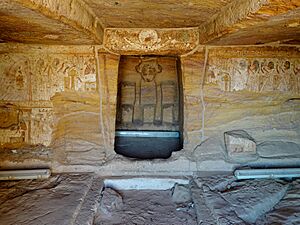Aniba (Nubia) facts for kids
Aniba was an important ancient village in Nubia, a region in northeastern Africa. It was located about 230 kilometers (143 miles) south of Aswan, a city in Egypt. Today, Aniba is covered by the waters of Lake Nasser, a large reservoir created by the Aswan High Dam. In ancient times, this village was known as Miam and was a very important town. The land around Miam was known for being very fertile, meaning it was great for growing crops.
Contents
Aniba: A Glimpse into Ancient Nubia
Early History and Egyptian Rule
The oldest signs of human life at Aniba date back to around 3000 BC. These early people belonged to a group called the A-Group culture. Archaeologists have found several cemeteries from this time.
Later, during the Middle Kingdom (from about 2000 to 1700 BC), the Egyptians took control of this region. They built a strong fortress and a small town at Aniba. This was during the Twelfth Dynasty of Egypt.
Growth and Importance in the New Kingdom
At the start of the New Kingdom (around 1550 BC), the town of Aniba grew much larger. It expanded to about 200 by 400 meters (650 by 1300 feet). A strong wall and gates were built around it. As the New Kingdom continued, the town kept growing and even developed several neighborhoods outside its main walls.
Inside the main town, there was a temple dedicated to Horus of Miam. Horus was an important ancient Egyptian god. When archaeologists dug up the temple, it was not in very good condition. However, they believe its foundations were laid during the Middle Kingdom. Just north of the town, there was also a Nubian village. This village belonged to a group known as the C-Group Culture.
Burials and Important People
Around Aniba, many large cemeteries were found. Some of these tombs belonged to Nubian people. However, other tombs were built in a purely Egyptian style. It's not completely clear if the people buried in these Egyptian-style tombs were Nubians who adopted Egyptian customs, or if they were Egyptians living in Nubia.
One of the simpler tombs found belonged to an important official named Pinehesy. He held the title of Viceroy of Kush. This meant he was the highest Egyptian official in charge of the Nubian region. Pinehesy is also known from other historical records.
Another decorated tomb, carved into rock, belonged to Pennut. He was the deputy of Lower Nubia. This important job likely had its main office right there in Aniba. This tomb was later moved to New Amada to save it from the rising waters of Lake Nasser. This move was part of a big effort called the International Campaign to Save the Monuments of Nubia.
New Discoveries About Aniba
Recently, scientists have re-examined the pottery found at Aniba. They discovered that many tombs originally thought to be from the New Kingdom were actually from an earlier time, the Second Intermediate Period. This new information has changed how experts understand the timeline of Aniba's history.
Metal objects like tools and jewelry from the C-Group, Second Intermediate Period, and New Kingdom periods at Aniba have also been studied. Researchers found that these items were made from special types of copper, like arsenical copper and tin bronze. The metals likely came from places as far away as Cyprus, showing how connected Aniba was to other regions.


